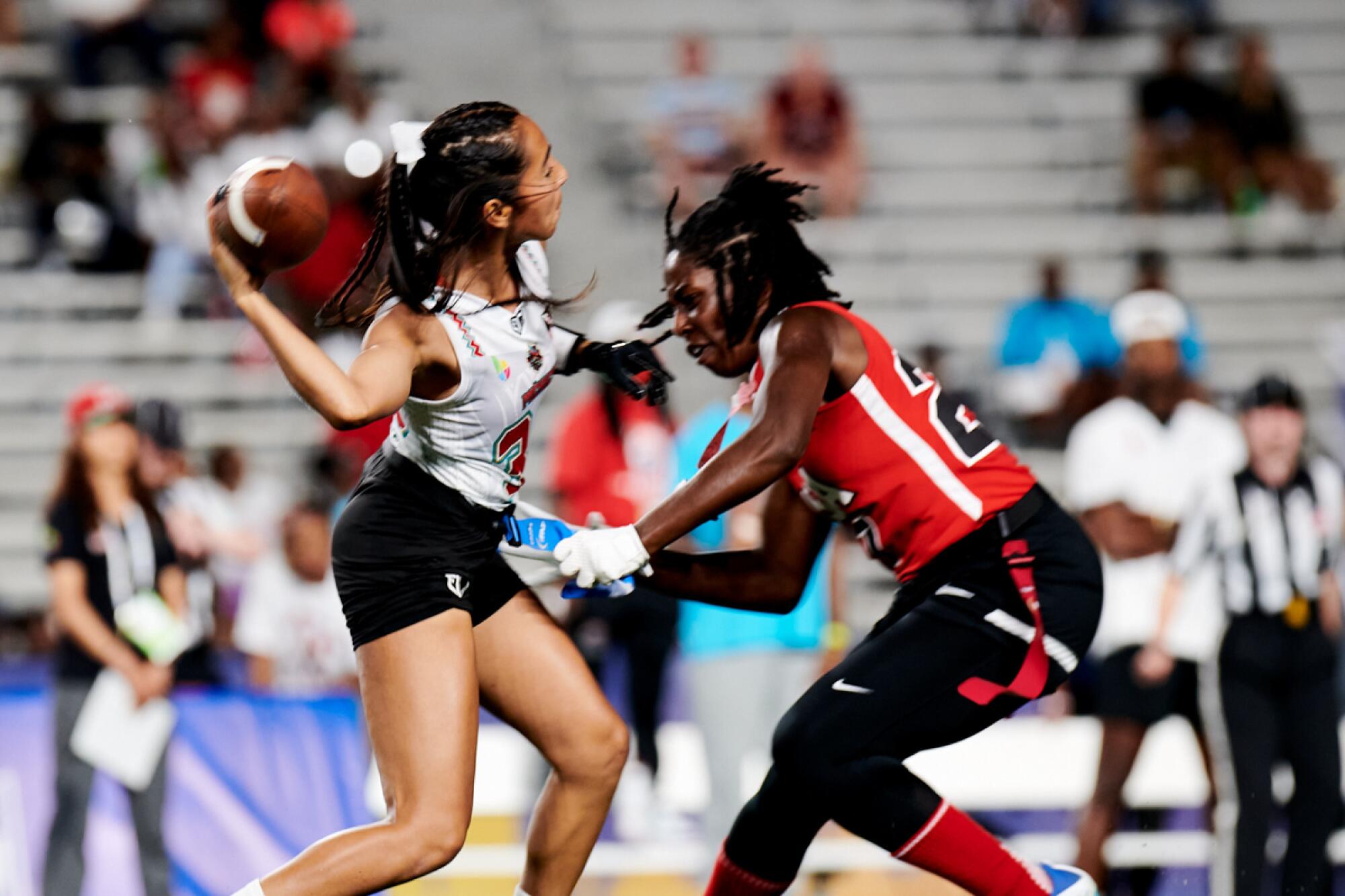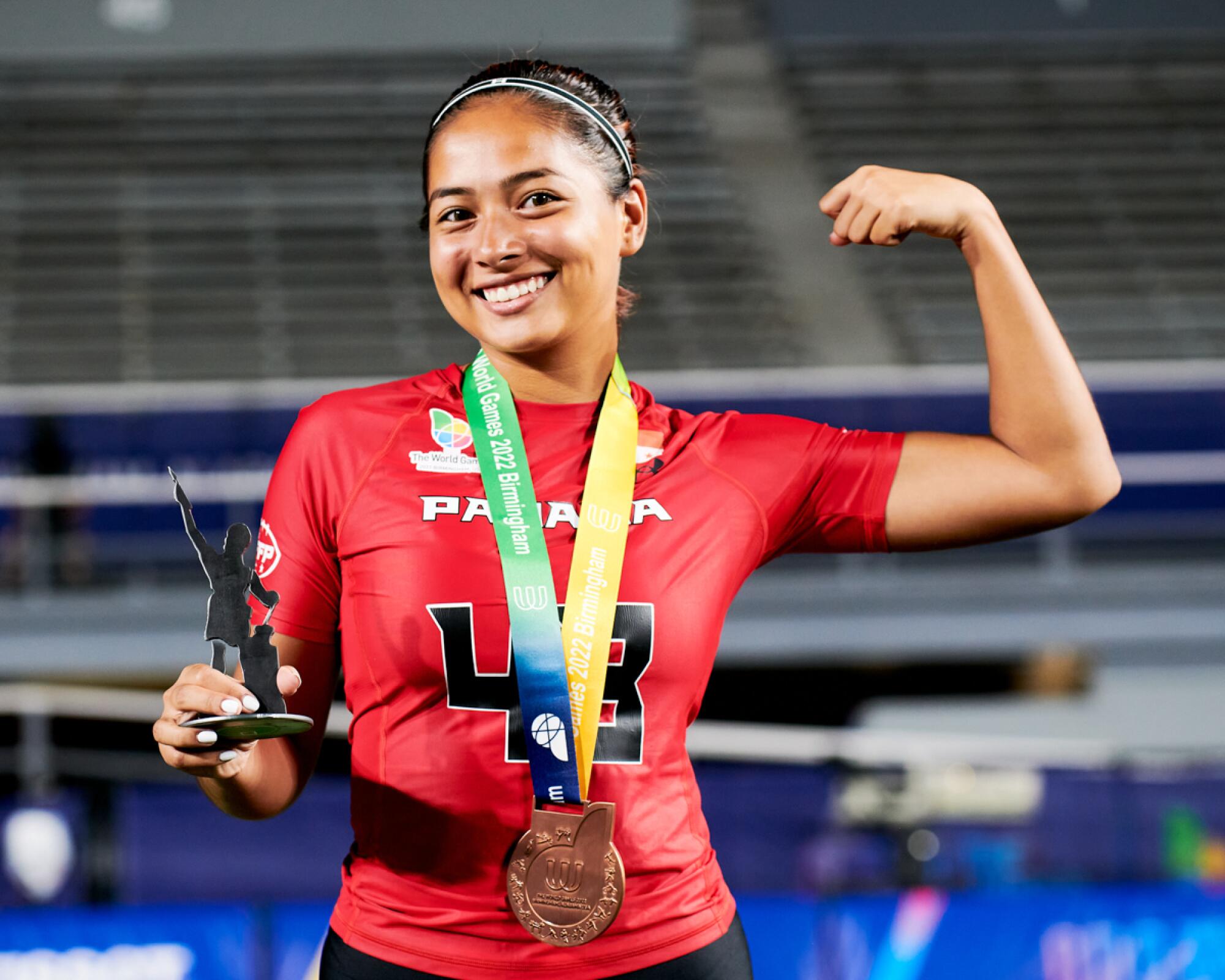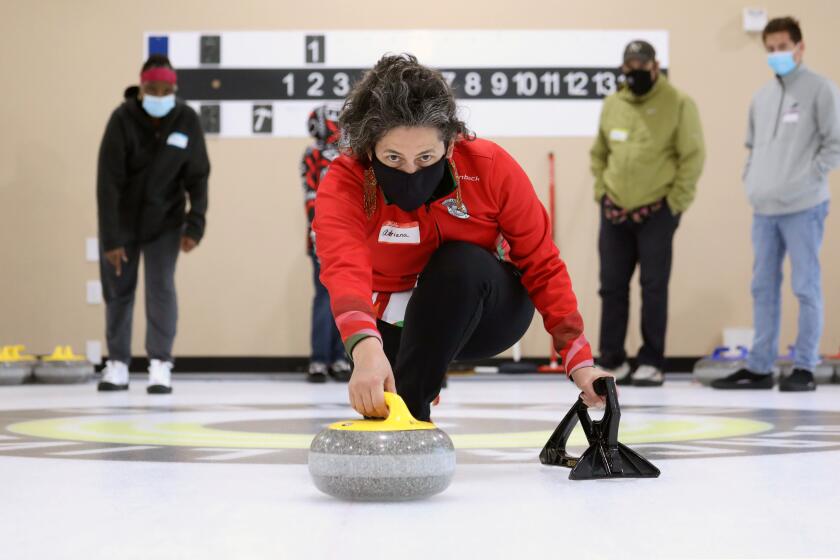
- Share via
At a sinewy 5-foot-3, Andrea Castillo looks like a soccer player — something she once was growing up in Panama.
But it didn’t take long to realize that “the beautiful game” wasn’t for her.
She was 12, just entering secondary school, when she gave up fútbol for the fledging sport of flag football. It proved to be a good move for the now 18-year-old, who this summer quarterbacked Panama to a bronze medal in the World Games in Birmingham, Ala.
“I think a lot about that,” she said of the decision to quit one of her country’s most popular sports for one that had little more than a cult following. “I’ve been growing with flag football. … I have had the opportunity to be in all these events and have all these achievements at a young age.”
The sport has blossomed almost as quickly as Castillo’s career. And while the global appeal of the National Football League has helped fuel flag football’s rise in Panama and elsewhere, about the only thing the two sports share is the shape of the ball.
Athletes from Mexico and Puerto Rico have dreams of competing in the Winter Olympics in curling.
Flag football is typically played with five people on a side on a field about two-thirds the size of an NFL gridiron, which makes for a wide-open game played at a breakneck pace. That also makes speed, agility and creativity more important than size or brute strength, a reason women and girls are flocking to the game in huge numbers.
The California Interscholastic Federation, which governs high school sports in the state, is considering a proposal to certify flag football as a varsity sport. Six states have taken that step already, and at least 20 others are exploring it.
The NFL is also on board.
The Rams and Chargers are sponsoring a league that includes 16 girls’ flag football teams in Southern California, and more than 10,000 girls are playing in NFL-sponsored leagues around the country. At the college level, 18 National Assn. of Intercollegiate Athletics schools in 10 states are playing women’s flag football this season, as are a handful of schools at the National Junior College Athletic Assn. level.
With more than half a million participants and 1,640 active leagues, according to the NFL, flag football is among the fastest-growing sports in the U.S.

“That’s the beauty of flag football. Everyone can play. It’s accessible and inclusive.”
— Andrea Castillo, Panama quarterback
“You can see the opportunity, and now to introduce the sport to high school girls, this is a generational impact that we’re having,” said Jonathan Franklin, director of social justice and football development for the Rams.
Franklin said the NFL has emphasized girls’ flag football because virtually every high school in the country has a tackle-football program for boys.
“As we look at inclusion and opportunity, there has not been access necessarily for girls to play in a safe way,” he said. “So through this pilot program, we wanted to make sure that we give girls an opportunity to have ownership of their own sport, to grow their sport, to create that passion, that desire.
“There are boys-only sports, right? Now let’s create opportunities for girls.”
The sport also has a large following in Latin America, thanks in part to the simplicity of the game. Like soccer, all it requires is a small open space, a ball and a handful of friends.
And gender doesn’t matter, Castillo said.
“That’s the beauty of flag football. Everyone can play. It’s accessible and inclusive,” she said. “We don’t have any problem with the gender thing in Panama with flag football. Women have been represented a lot and play football and we have done a great job.”
“It empowers women. It gives equal representation on the field. So there’s no limits.”
— Diana Flores, flag football quarterback
Diana Flores of Mexico City was drawn to the sport when she was 8. Her father — who played quarterback for Monterrey Tech, Mexico’s top college program — took her to a practice and she was hooked, quitting piano and dance lessons to play flag football instead.
Because there were no teams at the time for girls her age, she had to compete against players twice as old, a handicap she turned into an advantage.
“I was playing with girls that were taller than me, of course faster than me,” she said. “But I learned to focus on my abilities, on the things that made me better, and to work on them. … It gave me the opportunity to grow as an athlete and as a person.”
Eight years later, she made Mexico’s national team, playing in the first of four Flag Football World Championships in which she has appeared so far. This year, as Mexico’s starting quarterback at age 24, she beat the U.S. twice — the second win coming in the World Games final, where she completed 20 of 28 passes for 210 yards and four touchdowns in a 39-6 romp.
Mexico’s women’s team is the most successful in the history of the sport, winning three gold medals, a silver and a bronze in the International Federation of American Football World Championships, a competition that is held every two years.
Commentary: College football review: How Lincoln Riley’s hot USC start affects Nebraska, Urban Meyer
USC is being rewarded for chasing Lincoln Riley. Nebraska fans are envious of the Trojans’ rapid makeover, pushing them to overlook Urban Meyer’s flaws.
“It empowers women,” Flores said of flag football, which in Mexico challenges not only sporting stereotypes but gender ones as well. “It gives equal representation on the field. So there’s no limits.”
According to Flores, an estimated 3 million people play flag football in Mexico, where colleges are beginning to award scholarships for women to play.
“This is just a first step for opening new paths and new opportunities. Not only Mexico, but worldwide,” she said. “That’s why I’m happy to be an ambassador and start opening those doors.”
One door she hopes will open soon is the one leading to the Olympics. Flag football is one of nine sports that last month petitioned for inclusion in the 2028 Los Angeles Games, alongside motorsports, cricket, karate, baseball/softball, lacrosse, kickboxing, breaking and squash.
The sport would appear to have key aspects that the International Olympic Committee looks for: It’s fast, has a manageable number of players and a strict time limit — with halves lasting between 15 and 25 minutes, depending on the competition.
Rosters are 15 players deep and contact is not allowed, which means no tackling, diving, blocking or screening. Instead, players wear flags that hang along their sides on a belt; to “tackle” the ballcarrier, an opponent must pull off one of the two flags.
There are no punts or kickoffs. Pass rushers must start seven yards off the line of scrimmage, and quarterbacks have just seven seconds to get rid of the ball; they can’t run with it unless they hand it off to a teammate first.
The San Diego Wave won 1-0 over Angel City on Saturday night at the new Snapdragon Stadium before a sellout crowd announced at 32,000, an NWSL record.
Flag football’s inclusion in the World Games, which were first held in 1981 to highlight events competing for a spot on the Olympic calendar, was an important step in getting global recognition. (This summer’s competition featured 3,600 athletes from 110 countries competing in 30 events, including wheelchair rugby and tug of war.)
The IOC is expected to announce its decision regarding additional sports for the Los Angeles Games at its general meeting next spring in Mumbai.
Flores isn’t holding her breath.
But then, she said, she doesn’t need an Olympic medal to validate her career. Flag football has taken her to competitions in Italy, Denmark, Israel, the U.S. and Central America. What she wants to do is give back to the game by helping it grow.
“I’m here and I’m one of the best in the world, you know? So to be able to show to all the little girls that they are able to do that, I think that’s what we’re doing,” she said. “We’re inspiring women and young kids to dream big. And to see that it is possible for their dreams to come true. It is possible to do everything they want.”
More to Read
Go beyond the scoreboard
Get the latest on L.A.'s teams in the daily Sports Report newsletter.
You may occasionally receive promotional content from the Los Angeles Times.














